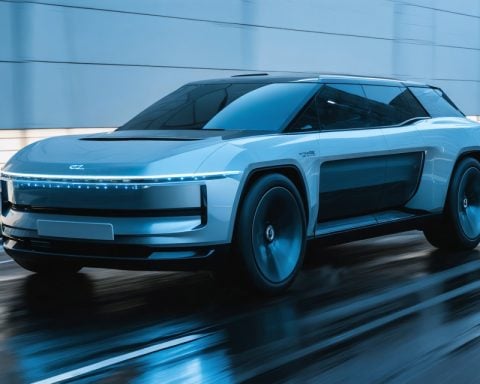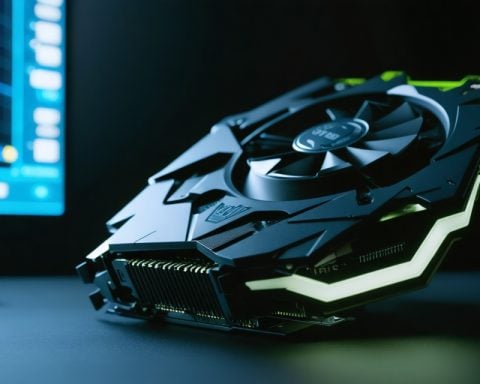- Rivian Automotive’s stock price fell by 9.7%, reaching a new low due to investor concerns.
- Bank of America downgraded Rivian’s stock, setting a price target of $10 per share amid a challenging EV market.
- Despite recording a $170 million quarterly gross profit through improved supply chain management, skepticism remains about Rivian’s future projections.
- Rivian’s 2025 delivery forecast is capped at 51,000 units, unchanged from last year’s figure, raising concerns.
- Collaboration with Volkswagen promises future innovations, but current challenges overshadow progress.
- A potential freeze on clean energy funding may affect Rivian’s $6.6 billion loan from the Department of Energy.
- Rivian stands at a crossroads of ambition and risk, requiring careful consideration from investors and enthusiasts.
Rivian Automotive, once a shimmering beacon in the burgeoning electric vehicle market, experienced a sharp jolt to its momentum as its stock price plummeted by an alarming 9.7%. This nosedive brought the EV maker’s shares down to a disconcerting new low, reflecting growing unease among investors just as Rivian’s outlook turned murky.
The wheels came off when Bank of America analysts moved with caution, downgrading Rivian’s stock rating and slicing the price target to $10 per share. Rivian, hovering perilously around $11.71, faced skepticism despite being labeled a viable contender in the EV sector. Concerns arose primarily from Rivian’s understated forecast for 2025, painting a challenging picture against the backdrop of a slowing global EV market and intensifying competition.
In a significant stride, Rivian recorded its first quarterly gross profit, a shining $170 million in Q4, a feat realized through sharp supply chain management and a leaner production line focusing on its upgraded R1 vehicles. The financial achievement did little to soothe analysts rattled by Rivian’s tempered 2025 delivery projections. While last year saw a promising delivery of over 51,000 units, projections for 2025 curiously cap at 51,000.
Much hinges on Rivian’s collaboration with Volkswagen, solidified by a $5.8 billion joint venture aimed at unleashing future innovations like the eagerly anticipated R2 and R3 SUVs. Yet, as the world waits for these upcoming releases, the present casts a shadow on Rivian’s glowing prospects. The looming freeze on clean energy funding exacerbates these risks, potentially jeopardizing Rivian’s $6.6 billion loan agreement with the Department of Energy.
In this volatile market, Rivian remains perched between potential and peril, its path marked by groundbreaking ambition yet shaded by risk. Investors and enthusiasts must weigh their optimism with caution as the future of this electric pioneer unfolds.
The Untold Story of Rivian: Challenges, Prospects, and How It Affects You
How-To Steps & Life Hacks for EV Investments
Investing in electric vehicles (EVs) can be a daunting endeavor, given the market’s fluctuating dynamics. Here are strategic steps for investing in the EV sector:
1. Research Thoroughly: Understand the company’s technological edge—like Rivian’s focus on electric trucks and SUVs—and its market position.
2. Evaluate Financial Health: Look at quarterly earnings, like Rivian’s first recorded gross profit of $170 million, which reflect financial stability and growth potential.
3. Monitor Market Trends: Stay updated on industry trends, such as Rivian’s strategic alliances, which shape future growth.
4. Assess Risks: Identify risks, like competition and funding dependencies, to balance potential returns.
5. Diversify: Don’t just stick to one EV company. Consider a diversified portfolio including emerging players alongside established giants.
Real-World Use Cases & Market Trends
Rivian’s R1 series is particularly appealing for outdoor enthusiasts and is engineered for rugged terrains. However, recent trends in the EV market show a slow global adoption rate and heightened competition from companies like Tesla and Lucid Motors, raising significant challenges.
The global EV market is expected to grow at a CAGR of about 29% from 2021 to 2028. However, Rivian’s muted delivery forecast for 2025 suggests a need to recalibrate expectations. Partnerships, like their venture with Volkswagen, point to a focus on synergies and shared innovation.
Reviews & Comparisons
Rivian’s unique selling proposition largely centers around its robust design and advanced off-road capabilities, setting it apart from rivals such as Tesla in the lifestyle and utility segment. Experts often commend Rivian for its vehicle endurance but criticize the company’s pricing strategy and delivery delays.
Controversies & Limitations
The EV maker faces scrutiny over its projected delivery volumes, suggesting operational bottlenecks. The controversial downgrade by Bank of America, coupled with delayed product rollouts, raises concerns about leadership and strategic clarity.
Features, Specs & Pricing
Rivian’s R1T and R1S models offer luxury features, including:
– Dual-motor AWD system
– High ground clearance for terrain navigating
– Cutting-edge infotainment systems
Priced around $70,000 to $75,000, these models are positioned as premium offerings, justifying their richer feature set.
Security & Sustainability
Rivian aims for sustainable production, but their dependency on energy funding remains a potential vulnerability. The reliance on the Department of Energy’s $6.6 billion loan could affect sustainability goals amid policy changes.
Insights & Predictions
Experts predict Rivian will stabilize its output by 2025 despite looming challenges. The company’s shift towards alliances, like the joint venture with Volkswagen, will be key in expanding their product lineup and market reach.
Tutorials & Compatibility
Rivian cars generally come with comprehensive online manuals and customer support tutorials aiding with new feature navigation and regular maintenance checks.
Pros & Cons Overview
Pros:
– Innovative vehicle design
– Strategic partnerships enhancing market appeal
– Successful gross profit milestone
Cons:
– Uncertain delivery projections
– Relatively high pricing
– Heavy reliance on external funding
Conclusion: Recommendations & Quick Tips
For prospective investors and consumers eyeing Rivian, consider the balance between its innovative promise and the hurdles faced.
– Keep an eye on Rivian’s partnership developments as they signal potential market advances.
– Monitor funding changes and government policy updates that could impact pricing and production.
– Think long-term for investments as market volatility might cause near-term swings.
Explore further about the electric vehicle industry and Rivian’s journey by visiting trusted domains. For example, check out Rivian for the latest developments in their electric vehicle offerings and market strategies.



















